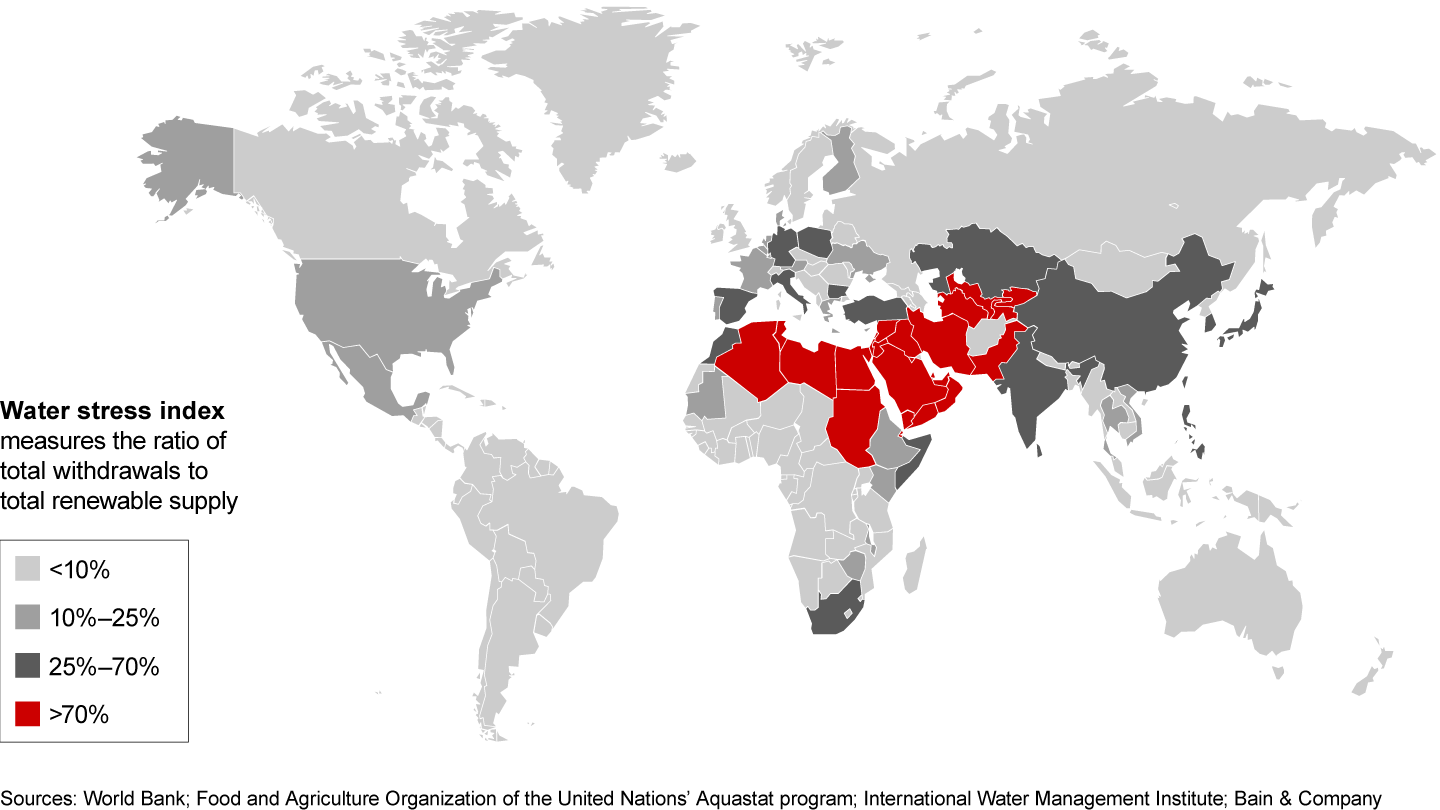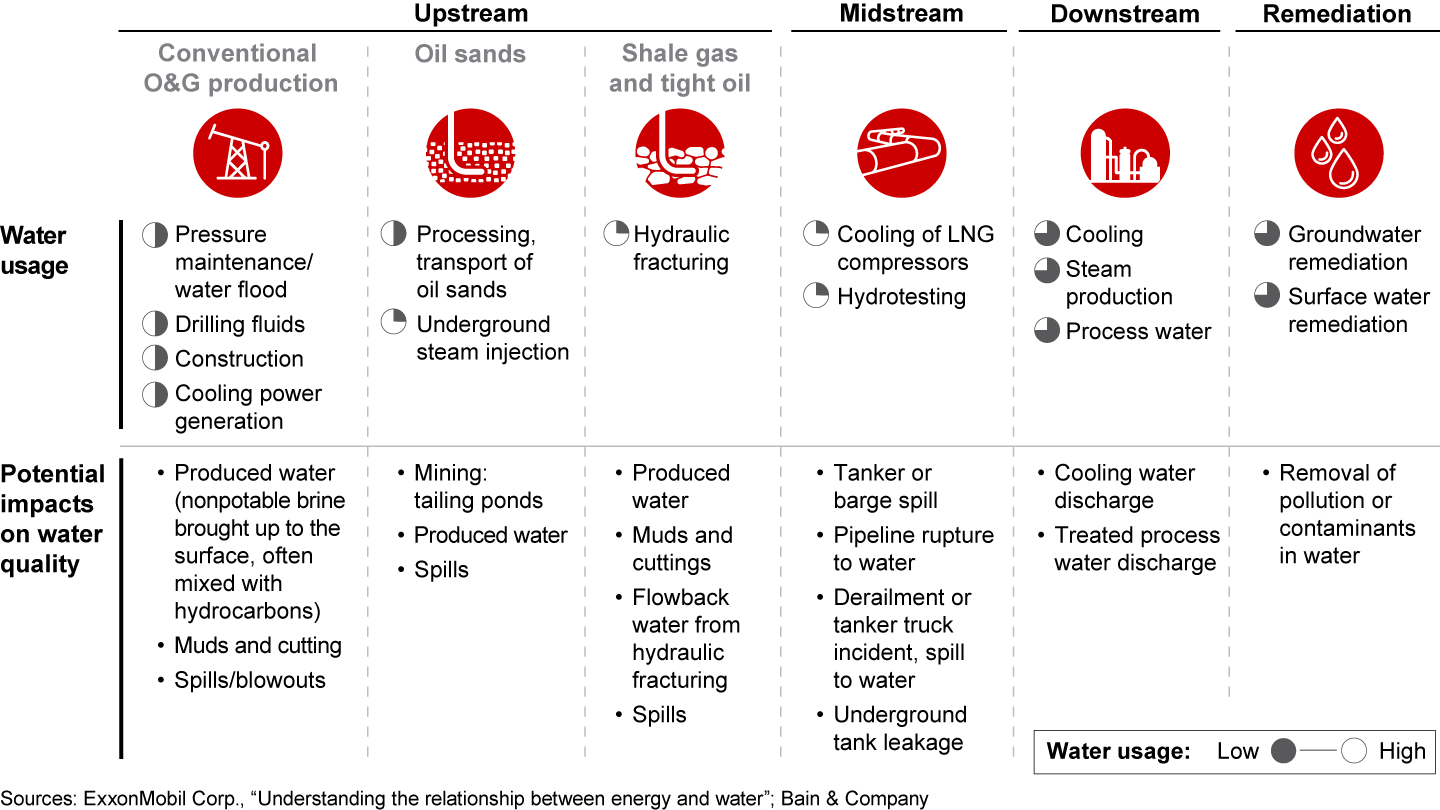Etude

En Bref
- Some of the most water-stressed regions in the world are also the locations of intense oil and gas activity. Given that water is critical for oil and gas production, energy companies need to become more efficient in the ways they use water, from upstream exploration through refining.
- Oil and gas companies are uniquely qualified to tackle the challenging issues around water sustainability in many regions of the world, given their engineering expertise, construction capabilities and access to investment funds.
- Working on water sustainability issues can strengthen energy companies’ relationships with relevant stakeholders, including governments and local populations.
Water scarcity is an increasingly critical issue in many parts of the world. As cities and economies grow and as the climate changes, water resources come under greater pressure, placing the people and industries that depend on them at risk.
The Middle East and North Africa, areas with intensive oil and gas production activity, are among the most water-stressed regions in the world (see Figure 1). The OECD estimates that water-related losses in agriculture, health, income and property could limit economic gains in those regions and contribute to a 6% decline in global GDP by 2050.

Water risks pose a threat to many businesses, but the oil and gas sector is particularly exposed because of its requirements for vast amounts of water across the value chain and the geographical overlap between many of its operations and the places where water is most scarce. Water risks carry the potential to interrupt production, increase operating expenses, and damage reputations and relationships with regulators and local populations.
At the same time, the oil and gas sector is particularly well suited to take the lead in managing water scarcity issues, given its engineering expertise, access to investment funds and its many operations in water-stressed regions. Increasingly, oil and gas companies are tapping their expertise to develop innovative approaches to solving water issues, from programs that increase efficiency of water usage in their operations to partnerships that deliver clean water to local populations. A successful track record of water treatment projects not only ensures that this essential resource remains available for operations; it also strengthens relationships between oil and gas companies and local stakeholders, including regulators and members of local communities.
Shell, for example, worked with the government of Oman to develop an industrial wetland to treat enormous volumes of water used in production in that country’s Nimr oilfield. Since 2011, Shell has used large fields of sloping wetlands and evaporation ponds to process more than 100,000 cubic meters of (used) water every day, water which otherwise would have needed to be injected into deep well aquifers.
Projects like the Nimr wetlands are impressive on their own, but more so when they make up a part of a larger, comprehensive approach to water management. Oil and gas companies in general, and international oil companies (IOCs) in particular, will need to define and follow broad strategies to address water scarcity issues across their operational footprint. Developing the capabilities to manage water issues and forge partnerships with NGOs focused on water issues could represent a source of differentiation for IOCs, one that highlights their unique value proposition for investors, local stakeholders and national oil company (NOC) partners.
A strategic approach to water management
A comprehensive approach to water management begins with a clear understanding of the risks associated with water scarcity and potential impacts on the core business, including interruptions in operations or increases in operating expenses. Leading oil and gas companies continuously assess their exposure to water risks, developing a deep understanding of their water needs across the value chain and within local contexts. These assessments take into consideration the potential economic, social and environmental implications of water risks, as well as the reputational risks associated with water issues (see Figure 2).

To help mitigate those risks, leading oil and gas companies take three kinds of actions.
- Optimize water efficiency. In order to make the best use of available water resources, oil and gas companies will need to work with local partners to develop innovative solutions.
For example, in 2015 Eni began to investigate water consumption in the water-stressed Bhit and Badhra regions of Pakistan. Eni identified areas for improvement in managing water, including better management practice and new infrastructure, along with the need to increase awareness of the importance of water resources among employees and local communities. The company also invested in the water distribution network for civil and industrial usage, started the reuse of water from treatment plants for irrigation and invested in plant improvements to make better use of water.
- Manage wastewater efficiently. Wastewater is also an asset, which companies can use to reduce their demand for fresh water—which in turn cuts costs and increases sustainability. Leading companies protect local water supplies and the environment from pollutants and contamination by developing effective programs to treat water used in their production processes.
Reusing water was part of BP’s plan to lower consumption of fresh water at its refinery in Kwinana, Western Australia. BP designed and implemented a water minimization and reuse plan for the refinery and, in partnership with the government and other industrial players, built a new water treatment plant at the refinery with connections to the local water distribution system. As a result, the refinery’s total water use dropped 42%, and its potable water use dropped by 93%, from 1996 to 2014.
- Fund remediation and sustainability projects. Finally, leaders invest in a long-term vision that aims to continuously improve water quality and the access to water supply. They implement programs to reduce or remove any effects that oil and gas operations have on water resources. These projects are also important in building lasting relationships with local governments and populations.
Repsol had this long-term vision in mind when it worked with the United Nations Development Program to carry out the Communities Benefit Plan (PBC) for indigenous people of Colombia with limited access to potable water. The agreement includes construction of two micro-aqueducts and maintenance of four water reservoirs that benefit more than 1,600 people from 18 communities. Repsol also helped local indigenous communities to develop the capacity to maintain 1,200 water wells and windmills.
New opportunities in water management
Investing in water projects can help oil and gas companies deepen their partnerships with NOCs, investors, NGOs and local communities. In many cases, oil and gas companies are the only available players with the capabilities, the resources and the motivation to address water scarcity issues—and doing so may deliver attractive visibility and a competitive edge in competition for concessions. Developing and promoting a handful of projects, however, is unlikely to secure the future. Leading oil and gas companies will create a structured and holistic approach to water management programs, developing strategies based on in-depth risk-benefit analyses.
Water projects also represent an attractive opportunity in and of themselves: The global opportunity in water is significant, worth about $770 billion, and growing at about 3.5% annually over the next five years to reach more than $900 billion by 2023. By tapping the technical capabilities of their engineering and managerial workforce, oil and gas companies can ensure the sustainability of their own water-reliant processes and enter a growing field where their existing footprint gives them a competitive edge.
Carlo Zandi is a principal and Robert Nava is a partner with Bain & Company’s Energy & Natural Resources practice, working with the oil and gas sector. Both are based in Milan.

